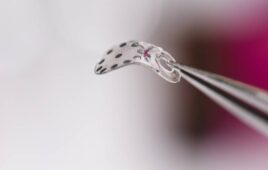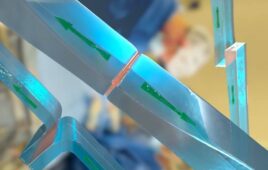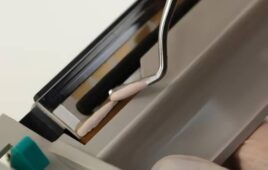
[Image from MIT]
Massachusetts Institute of Technology researchers have developed a thin, lightweight and rubber-like adhesive film that sticks to highly deformable regions of the body. The kirigami-inspired film has a pattern of slits that the researchers cut into, which is a key to the film’s adhesiveness.
The researchers attached the newly-developed film to a volunteer’s knee. When she bent her knee, the slits on the film opened up at the center and where the most bending was occurring. The slits that were on the edges of the film stayed closed, which allowed the film to stay on the skin. The kirigami-inspired cuts allows the film to stretch and have better grip.
After the success of the film, the researchers created an adhesive bandage using the same kirigami cuts. They also created a heat pad with the kirigami film threaded with the heating wires. The heating pad had a 3V power supply that allowed the pad to stay at a temperature of 100ºF. The researchers also created a wearable electronic film that was outfitted with light-emitting diodes. All of the films that the researchers developed stuck to the skin and withstood 100 knee bends.
“Currently in the soft electronics field, people mostly attach devices to regions with small deformations, but not in areas with large deformations such as joint regions, because they would detach,” Ruike Zhao, the lead author on the study, said in a press release. “I think kirigami film is one solution to this problem commonly found in adhesives and soft electronics.”
Zhao and her team were approached by a medical supply company that developed pain relief patches and were asked if they could develop an improved version of the bandage.
“Adhesives like these bandages are very commonly used in our daily life, but when you try to attach them to places that encounter large, inhomogenous bending motion, like elbows and knees, they usually detach,” Zhao said. “It’s a huge problem for the company, which they asked us to solve.”
Kirigami is an Asian folk art that involves cutting intricate patterns into paper and folding the paper like origami to make elaborate 3D structures. The researchers suggest that other scientists have been using the art form to develop functional materials.
“In most cases, people make cuts in a structure to make it stretchable,” Zhao said. “But we are the first group to find, with a systematic mechanism study, that a kirigami design can improve a material’s adhesion.”
The researchers created the film by pouring liquid elastomer into 3D printed molds that were printed with rows of offset grooves of a variety of spacings. The researchers filled the grooves with the rubber solution. Once it all cured, the thin elastomer had rows of offset slits. The researchers suggest that this method could be replicated using different materials, from soft polymers to hard metal sheets.
Zhao and the researchers applied a thin adhesive coating to each film to mimic a bandage and attached the film to a volunteer’s knee. The researchers compared the film’s ability to stick after repeated bending with a film with no kirigami cuts. After one cycle, the film with no cuts quickly detached from the knee and the kirigami film stayed after 100 bends.
The researchers said there are three main reasons that the kirigami films are adhesive. The first is shear-lag, meaning the shear deformation of the film reduces strain on other parts of the film. The second is partial debonding which is when the film segments around the open slits are able to maintain a partial bond. The third reason is inhomogeneous deformation which means the film is able to maintain its adhesion despite the bending surface area beneath it.
“These three parameters will help guide the design of soft, advanced materials,” Zhao said. “You can always design other patterns, just like folk art. There are so many solutions that we can think of. Just follow the mechanical guidance for an optimized design, and you can achieve a lot of things.”
The researchers have filed a patent for the film and are now working on using kirigami cuts on other materials.
“The current films are purely elastomers,” Zhao said. “We want to change the film material to gels, which can directly diffuse medicine into the skin. That’s our next step.”
The researcher was published in the journal Soft Matter and was supported by the National Science Foundation and the Tibet Cheezheng Tibetan Medicine Co.




